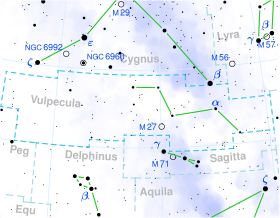| Observation data Epoch J2000 Equinox J2000 | |
|---|---|
| Constellation | Sagitta |
| Right ascension | 20h 20m 14.691s [1] |
| Declination | +21° 06′ 10.44″ [1] |
| Apparent magnitude (V) | 8.6-13.9 [2] |
| Characteristics | |
| Evolutionary stage | White dwarf (primary) [3] |
| Spectral type | Be [4] |
| Variable type | eclipsing and cataclysmic [2] |
| Astrometry | |
| Proper motion (μ) | RA: −2.133 mas/yr [1] Dec.: −6.489 mas/yr [1] |
| Parallax (π) | 0.3310±0.0206 mas [1] |
| Distance | 9,900 ± 600 ly (3,000 ± 200 pc) |
| Absolute magnitude (MV) | −2.2 [5] |
| Orbit | |
| Period (P) | 12.34 [3] hours |
| Semi-major axis (a) | 4.36 R☉ [6] |
| Inclination (i) | 65–80 [3] ° |
| Semi-amplitude (K1) (primary) | 320 [6] km/s |
| Semi-amplitude (K2) (secondary) | 85 [6] km/s |
| Details | |
| White dwarf (primary) | |
| Mass | 1.0 [3] M☉ |
| Donor (secondary) | |
| Mass | 0.8–1.0 [3] M☉ |
| Other designations | |
| AAVSO 1015+20, V Sge, GSC 01643-01764 | |
| Database references | |
| SIMBAD | data |
V Sagittae or V Sge is a cataclysmic variable in the constellation Sagitta. It is the only super soft X-ray source non-magnetic cataclysmic variable found so far. Lidiya Tseraskaya discovered the variability of this star, in 1902. [7] It appeared with its variable star designation in Annie Jump Cannon's 1907 work Second catalogue of variable stars. [8]

